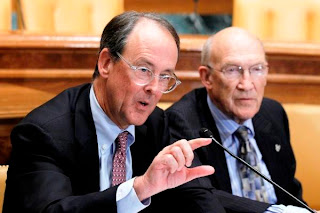 Virginians can rest assured that there are at least two serious budget cutters in Washington, D.C.: Erskine Bowles and Alan Simpson, co-chairs of the National Commission on Fiscal Responsibility and Reform. Their draft budget-balancing plan issued Wednesday gores so many oxen and butchers so many sacred cows that the Chicago Board of Trade would be well advised to suspend trading on cattle futures.
Virginians can rest assured that there are at least two serious budget cutters in Washington, D.C.: Erskine Bowles and Alan Simpson, co-chairs of the National Commission on Fiscal Responsibility and Reform. Their draft budget-balancing plan issued Wednesday gores so many oxen and butchers so many sacred cows that the Chicago Board of Trade would be well advised to suspend trading on cattle futures.
The co-chairmen’s plan would cut discretionary spending by $100 billion a year and defense spending by another $100 billion. One tax-reform option would eliminate $1.1 trillion in “tax expenditures” — special deductions, credits and exemptions not available to all — in order to raise hundreds of billions in new revenues while also lowering the top tax rates. The duo also tackles long-term entitlement reform and advances proposals for putting Social Security and Medicare on an actuarially sound footing. All told, the plan purports to achieve $3.8 trillion in deficit reduction through 2020, reducing the deficit to 2.2% of the economy by 2015.
As Simpson memorably puts it, invoking his own mammalian metaphor, “We have harpooned every whale in the ocean, and some of the minnows. No one has ever done that before.”
There is no assurance that the full commission will adopt the Bowles-Simpson plan. And even if the commission does sign on, there is no guarantee that Congress will enact any of it. Indeed, within hours of the plan’s release, a parade of politicians and special interests had expressed umbrage ranging in intensity from polite concern to outrage. (The co-chairs “just told working Americans to ‘drop dead,’ said AFL-CIO Chairman Richard Trumka.)
Still, the plan demonstrates the magnitude of change required to restore the United States to a fiscally sustainable path, and it punctures any illusions that budgetary rectitude can be restored without both cutting spending or by raising taxes. The co-chairs’ proposal will trigger the first serious budgetary debate this country has had in decades.
Bowles and Simpson articulate important guiding principles. “America cannot be great if we go broke,” they write. “Our country will not be able to compete without a plan to get this crushing debt burden off our back.”
Americans have spent the past two years making tough choices in their own lives, the co-chairs go on to say, and they expect the political leadership in Washington to do the same. “It is cruelly wrong to make promises we can’t keep. … We need to be willing to tell Americans the truth.”
To avoid disrupting the fragile economic recovery, the draft plan would delay making cuts until Fiscal 2012 and would phase them in gradually. While preserving the safety net for poor Americans, Bowles and Simpson focused on promoting economic growth and bolstering America’s economic competitiveness. Priorities include cutting red tape and inefficient spending that puts a drag on job creation, with the goal of making America “the best place to start and run a business and create jobs.”
Seventy-five percent of the budget gap is closed through spending cuts. The long-term goal is to “end redundant, antiquated, ineffective spending,” and also to improve the productivity of the federal workforce by 3% annually. Chopping the number of federal employees by 10% would save $13.2 billion annually by 2015.
Tax revenues would rise under the plan, but the tax code would be restructured to end economically unproductive credits, exemptions and deductions. Under “the Zero Plan” the top personal income tax rate would be rolled back to 23%, and corporate taxes to 26%. In other words, the plan actually would increase incentives for Americans to work hard and invest their capital productively.
The plan is far from perfect. I am dismayed that budget reform would deploy traditional budget-cutting controls to limit the increase in Medicare costs rather than focus on transforming the health care industry around the principles of productivity and quality. And I’m disappointed that Bowles and Simpson would slash security spending without articulating a scaled-back global strategy aligned with the military’s reduced force structure.
But those criticisms are remediable. What’s important is that Bowles and Simpson have changed the terms of debate in Washington. Whereas the Republican leaders of the House had been talking in terms of $100 billion in budget cuts, plus caps on spending, the benchmark has just shifted to $372 billion in savings by 2015 and $761 billion by 2020. The nation will have a very different discussion than the one that was shaping up a week ago.


